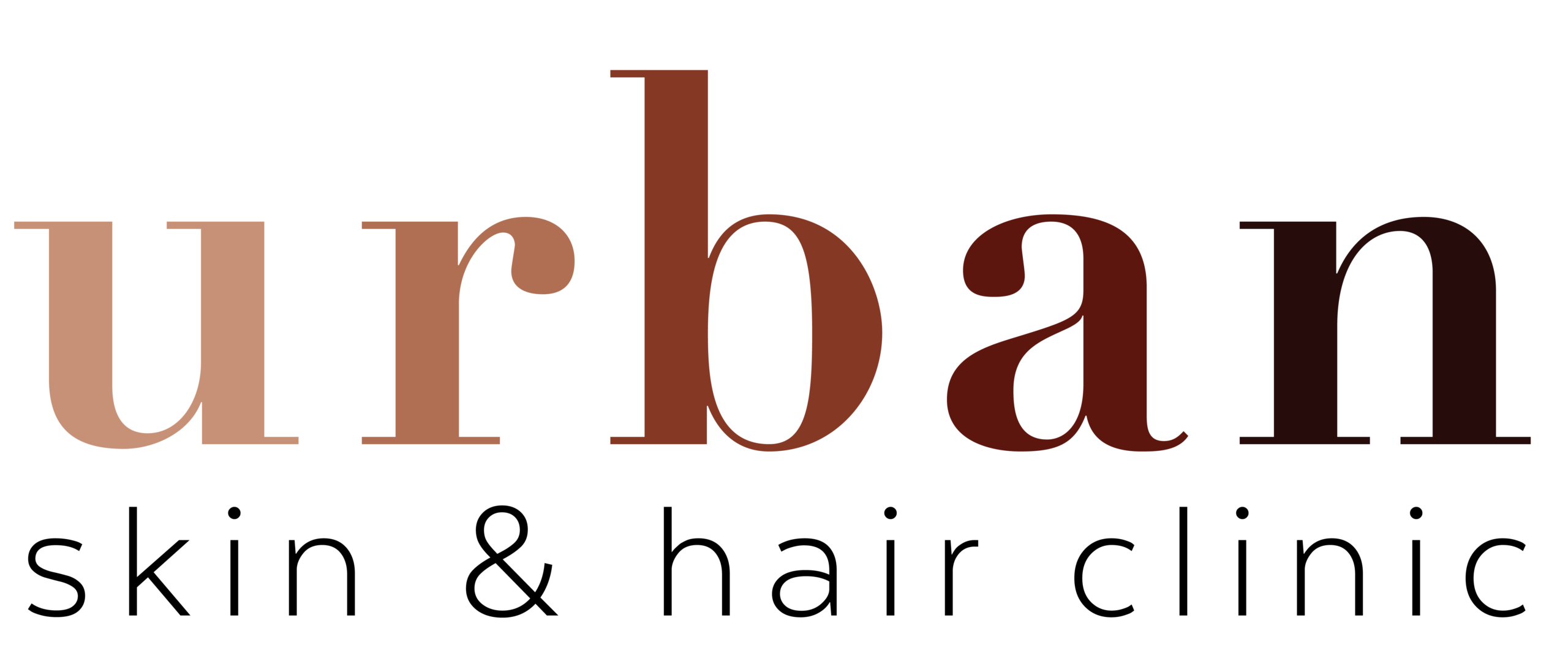
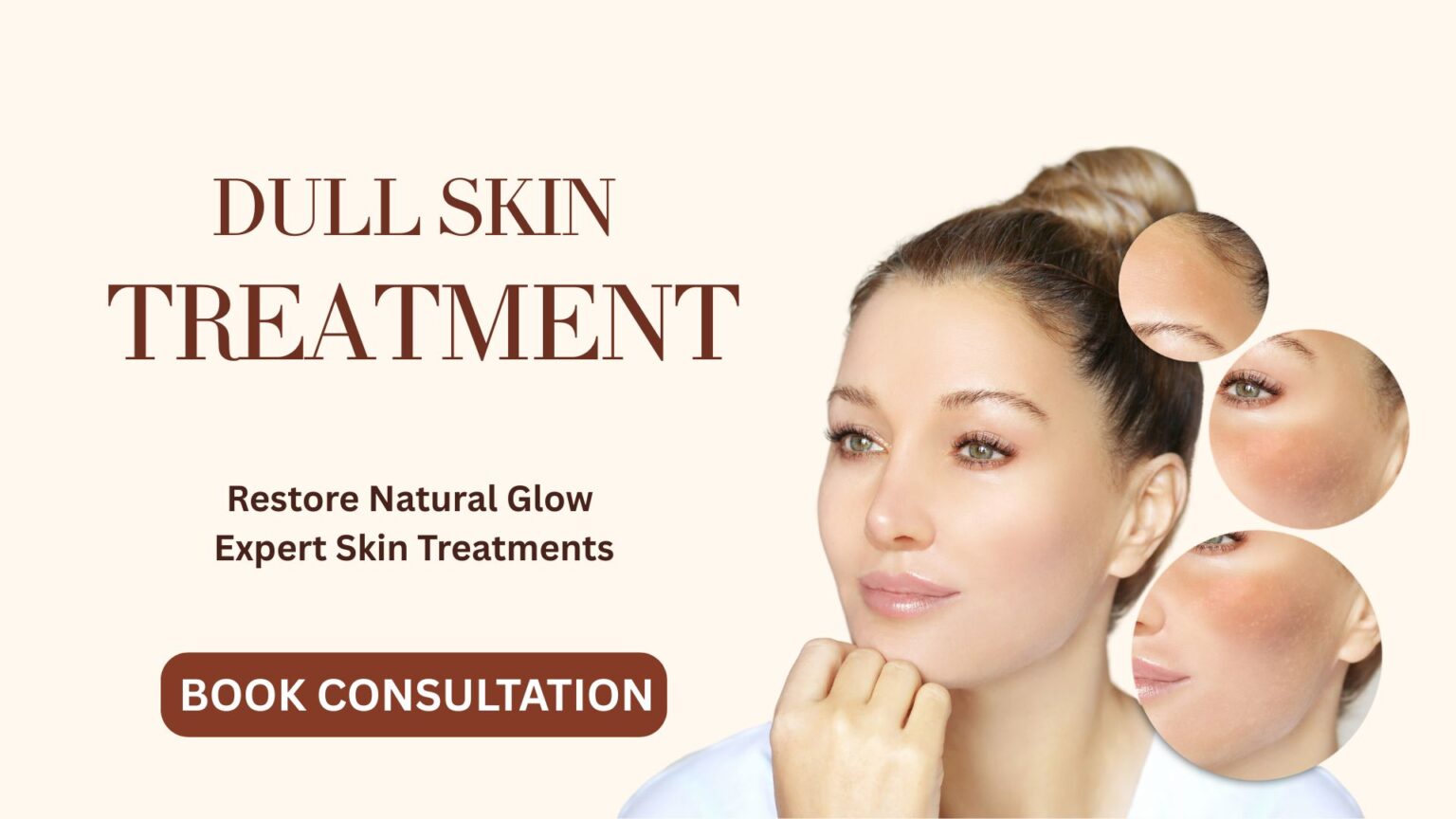
Introduction
Do you feel your skin lacks the natural glow it once had? Dull, tired skin can be caused by a variety of factors, including environmental stress, dehydration, and lack of sleep. At Urban Skin and Hair Clinic, we offer advanced Dull Skin Treatments designed to revitalize and rejuvenate your skin, restoring its natural radiance and youthful glow.
What is Dull Skin?
Dull skin refers to skin that appears lackluster, dry, and tired. This condition occurs when the skin fails to reflect light properly, resulting in a dull, uneven complexion. Factors like aging, poor lifestyle choices, environmental pollution, dehydration, and excessive exposure to the sun can contribute to skin becoming lackluster. While dull skin is not a medical condition, it can impact self-esteem and make you feel less confident about your appearance.
Causes of Dull Skin
Several factors contribute to dull skin, including:
- Dehydration: Lack of adequate hydration leads to dry, flaky skin, which can make your complexion appear dull.
- Sun Damage: Prolonged exposure to the sun can damage the skin, leading to uneven skin tone and pigmentation, contributing to dullness.
- Pollution and Environmental Stressors: Exposure to pollution and toxins can clog pores, impair skin functions, and cause dull, tired-looking skin.
- Aging: As we age, skin cell turnover slows down, leading to a buildup of dead skin cells on the surface, making the skin appear lifeless.
- Poor Diet: A diet low in vitamins and antioxidants can leave the skin looking tired and lackluster.
- Sleep Deprivation: Lack of sleep hampers skin regeneration and repair, leading to dull skin.
- Inadequate Skincare Routine: Skipping essential skincare steps such as exfoliation and moisturizing can lead to a buildup of dead skin cells, leaving the skin looking rough and dull.
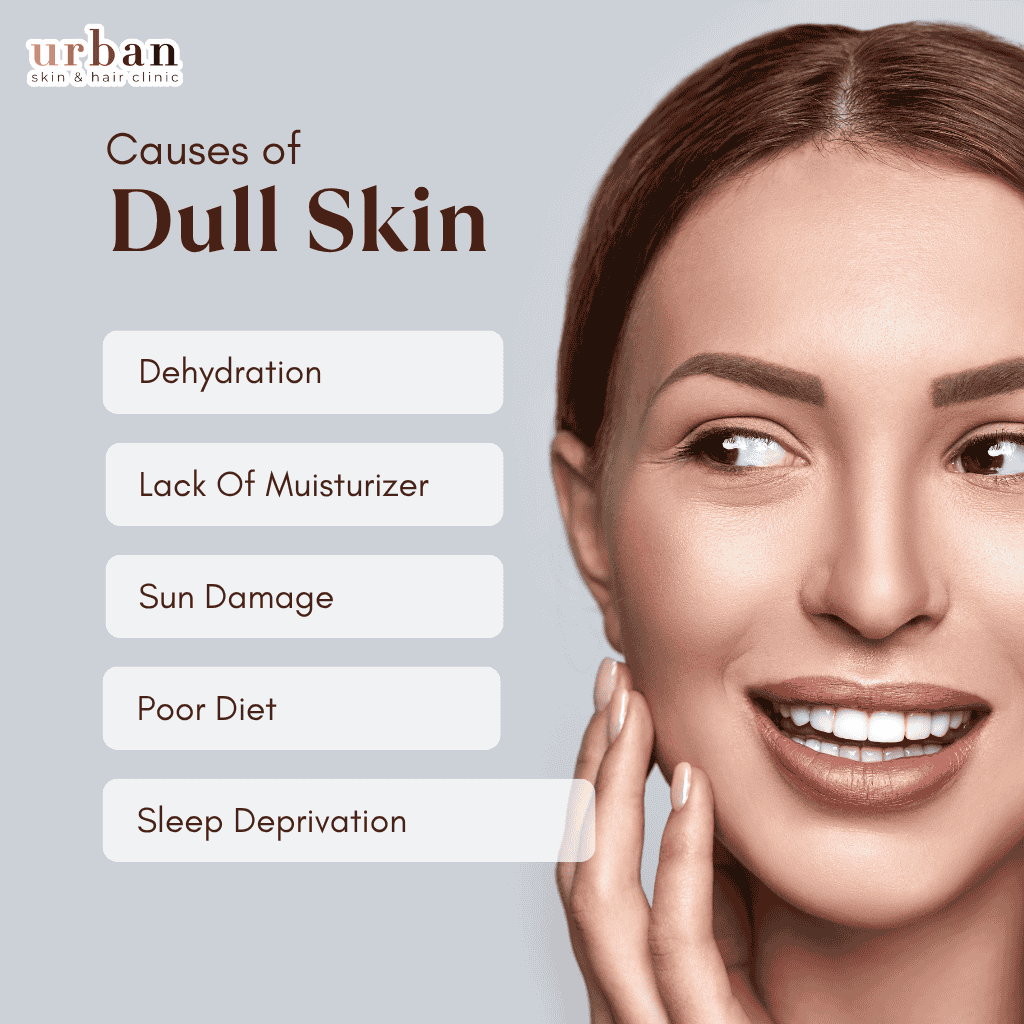
Treatment Benefits
✅ Revitalizes Skin: Our treatments help breathe new life into your skin, leaving it glowing and fresh.
✅ Exfoliates Dead Skin Cells: Removes the buildup of dead skin cells that contribute to a lackluster appearance.
✅ Improves Skin Texture: Smoothens rough patches and uneven skin tone.
✅ Enhances Hydration: Replenishes moisture, restoring the skin’s natural plumpness and glow.
✅ Reduces Fine Lines: Hydration and collagen-boosting treatments help minimize the appearance of fine lines and wrinkles, offering smoother skin.
✅ Brightens the Complexion: Targets dullness by boosting circulation and enhancing radiance.
✅ Non-Invasive Treatments: Our treatments are safe and gentle, with minimal downtime, giving you visible results without the need for invasive procedures.
Before-After Results
Our clients experience remarkable transformations, with their skin looking more radiant, smooth, and rejuvenated after just a few sessions. With the right treatments, dull, dry skin is transformed into healthy, glowing skin. Results may vary depending on the treatment plan and individual skin concerns, but most patients see visible improvements within a few sessions.

How to Prevent Dull Skin
- Hydrate Regularly: Drink plenty of water throughout the day to keep your skin hydrated and refreshed.
- Follow a Skincare Routine: Use a consistent skincare routine that includes cleansing, exfoliating, and moisturizing to maintain a fresh complexion.
- Wear Sunscreen: Protect your skin from harmful UV rays by applying sunscreen daily, even on cloudy days.
- Sleep Well: Ensure you get 7-8 hours of sleep each night to allow your skin to regenerate and repair.
- Eat a Balanced Diet: Include antioxidants, vitamins, and healthy fats in your diet to nourish your skin from within.
- Exercise Regularly: Regular physical activity increases blood circulation, which promotes healthy, glowing skin.
Our clinic offers a range of treatments to combat dull skin and restore your skin’s natural glow. Each treatment is tailored to your specific skin type and needs:
- HydraFacial: This treatment deeply cleanses, exfoliates, and hydrates the skin, leaving it glowing and refreshed.
- Chemical Peels: Medical-grade chemical peels remove dead skin cells and stimulate new skin growth, resulting in a brighter, more even complexion.
- Microneedling: Microneedling stimulates collagen production, improves skin texture, and gives you a smoother, more radiant skin surface.
- Laser Skin Resurfacing: Fractional laser treatment targets deeper layers of skin to improve texture, tone, and overall radiance.
- Oxygen Facial: A treatment that uses pure oxygen to deliver hydrating ingredients directly into the skin, giving it a healthy glow.
- PRP Therapy (Vampire Facial): This advanced treatment uses your own platelets to stimulate collagen production, improving texture and radiance.
- Vitamin C Facials: Boosts skin radiance by using vitamin C to brighten and hydrate the skin, helping to combat dullness.
Each of these treatments is designed to help restore your skin’s natural luminosity and improve texture, leaving you with youthful, glowing skin.
Treatment Options at Urban Skin and Hair Clinic
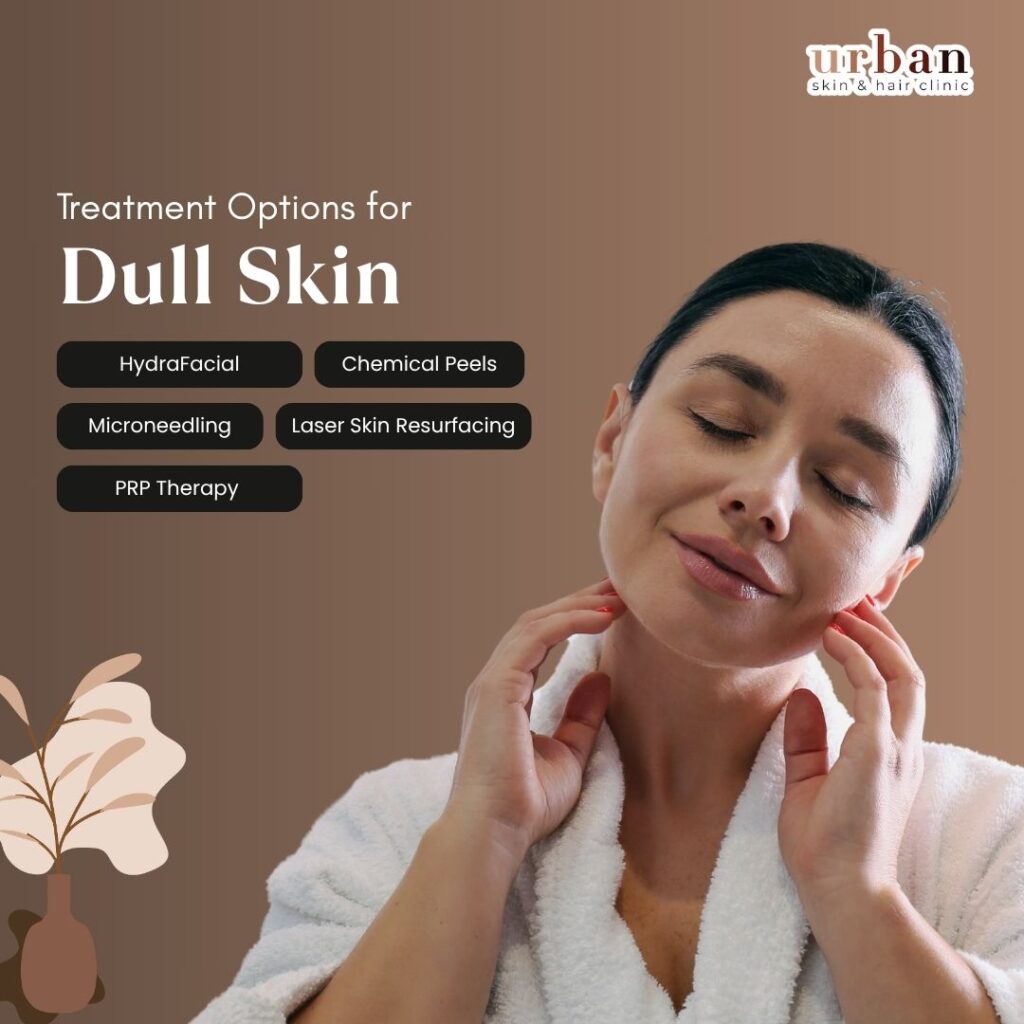
Introduction
Pimples are a common occurrence for everyone at some point. Hormones, stress, heredity, and nutrition are just a few of the possible triggers for pimples.
Pimples can be irritating when they come back again and again. At their worst, they may leave scars that last a lifetime, resulting in anxiety or melancholy.
Whatever method you choose to keep pimples at bay, remember that persistence and patience are the keys to success. While a single pimple may be reduced overnight with a dab of benzoyl peroxide, most treatments take several weeks to show any improvement.
Common Signs & Symptoms Of Dull Complexion
- Dryness or flakiness
- Rough or uneven skin texture
- Excessive oiliness or greasiness
- Enlarged pores
- Dull or lackluster appearance
- Tired or fatigued-looking skin
- Redness or irritation
- Acne breakouts or blemishes
- Uneven skin tone or discoloration.

Dull Skin Treatment Option
- Chemical peels are a cosmetic treatment that can improve the appearance of skin by removing dead, dull skin cells.
- The procedure involves applying a chemical solution to the skin, which causes the top layers of the skin to peel off.
- Chemical peels can be used to treat a variety of skin concerns, including fine lines, wrinkles, acne scars, hyperpigmentation, and sun damage.
- There are three main types of chemical peels: superficial, medium, and deep. The strength and depth of the peel will depend on the specific needs of the patient.
- Superficial peels are the mildest type of peel and only affect the outermost layer of skin. They are typically used to improve skin texture and tone.
- Medium peels penetrate deeper into the skin and can help to improve the appearance of fine lines, wrinkles, and mild acne scarring.
- Deep peels are the strongest type of chemical peel and can help to address more severe skin concerns, such as deep wrinkles and extensive sun damage.
- Chemical peels can cause some temporary side effects, such as redness, swelling, and peeling. However, these side effects typically subside within a week or two.
- It is important to follow proper aftercare instructions following a chemical peel, including avoiding sun exposure and using gentle skincare products
- Carbon peel is a non-invasive cosmetic treatment that uses carbon-based lotion and a laser to improve the appearance of the skin.
- The procedure involves applying a thin layer of carbon lotion to the skin’s surface, which penetrates the pores of the skin.
- A laser is then used to heat the carbon particles, causing them to vaporize and remove impurities from the skin.
- The carbon peel can help to improve skin texture, reduce the appearance of pores, and give the skin a brighter, more youthful appearance.
- Carbon peels are suitable for all skin types and can be particularly effective for those with oily, acne-prone skin.
- The procedure is generally painless, although patients may experience some mild discomfort or heat sensation during the treatment.
- There is no downtime associated with a carbon peel, and patients can resume their normal activities immediately after the procedure.
- It is important to follow proper aftercare instructions following a carbon peel, including avoiding sun exposure and using gentle skincare products.
- Carbon peels can be performed in conjunction with other cosmetic treatments, such as microdermabrasion or chemical peels, for even greater results.
- HydraFacial treatment is a non-invasive skincare procedure that can help to revitalize dull, tired-looking skin.
- The treatment involves using a specialized device to cleanse, exfoliate, and hydrate the skin, while also delivering targeted serums to address specific skin concerns.
- The treatment is customizable, meaning it can be tailored to your individual skin type and concerns.
- The procedure is painless and requires no downtime, meaning you can resume your normal activities immediately after the treatment.
- HydraFacial treatment can help to improve skin texture, reduce fine lines and wrinkles, and promote a brighter, more radiant complexion.
Topical Medications
The following are the most often prescribed topical medications for acne:
For mild acne, medications containing retinoic acids or tretinoin are often effective. These may be found in a variety of forms, including creams, gels, and lotions. Adapalene (Differin) and tazarotene are examples of tretinoin (Avita, Retin-A, and others), tazarotene (Tazorac, Avage, others). After three weeks of using it three times a week, you may go back to using it every day after your skin becomes adapted to it. It prevents hair follicles from becoming clogged. Do not use tretinoin and benzoyl peroxide at the same time.
Topical retinoids increase the sensitivity of your skin to the sun. Aside from that, they might create itchy or flaky skin, particularly in persons with darker complexions. Adapalene seems to be a well-tolerated medication.
Excess skin germs are killed, and inflammation and redness are reduced as a result. Use an antibiotic in the morning and an anti-retinol in the evening for a few months until your body adjusts to both. The use of antibiotics in combination with benzoyl peroxide helps prevent the spread of antibiotic resistance among bacteria and other pathogens. Benzoyl peroxide (Benzaclin, Duac, etc.) and erythromycin (with benzoyl peroxide) are two examples (Benzamycin). The use of just topical antibiotics is not advised.
Yeast produces azelaic acid, a naturally occurring acid. It’s antimicrobial, therefore it’s good for you. When used twice daily, azelaic acid cream or gel with 20 percent azelaic acid seems to be as effective as many conventional acne treatments. When you’re pregnant or breastfeeding, you may take prescription azelaic acid (Azelex, Finacea) to help with your symptoms. It may also be used to reduce acne-related discoloration. Skin redness and inflammation are possible side effects.
Salicylic acid, which is available in both wash-off and leave-on forms, may help prevent clogged hair follicles. There aren’t many studies to back up the success of this strategy. Skin discoloration and itching are possible side effects.
Oral Medications
For acne, there are a variety of oral medicines available.
Oral antibiotics may be required to treat moderate to severe acne if germs are present. When it comes to treating acne, tetracyclines (such as minocycline and doxycycline) or macrolides are usually the first options considered (erythromycin, azithromycin). In the case of expectant mothers and children under the age of 8, who cannot take tetracyclines, a macrolide may be a choice.
The use of oral antibiotics should be limited to periods that will not lead to the development of resistance. Benzoyl peroxide should be used in conjunction with antibiotics to minimize the development of antibiotic resistance.
Antibiotics seldom have serious negative effects when used to treat acne. These medications do raise your skin’s sensitivity to the sun’s rays.
Topical retinoids increase the sensitivity of your skin to the sun. Aside from that, they might create itchy or flaky skin, particularly in persons with darker complexions. Adapalene seems to be a well-tolerated medication.
The FDA has authorized four oral contraceptive combinations for women who also want to use them for contraception but have acne. These are progestin-estrogen combination products (Ortho Tri-Cyclen 21, Yaz, others). Because you won’t notice results from this therapy for many months, combining it with other acne drugs during the first few weeks is a good idea.
Weight gain, breast discomfort, and nausea are all common adverse effects of combination oral contraceptives. Cardiovascular disease, breast, and cervical cancers are all risks connected with these medicines.
Vitamin A derivative isotretinoin (Amnesteem, Claravis, and other brands) is used to treat acne. People with moderate to severe acne who have not responded to prior therapies may be administered this medication.
Inflammatory bowel illness, depression, and serious birth abnormalities are all possible adverse effects of oral isotretinoin. The FDA must authorize a risk management program for all persons taking isotretinoin. A visit to the doctor frequently will be required for monitoring of adverse effects.
Post-Care Instructions
Here are some post-care instructions to follow after a procedure:
- Avoid using any cleanser on your face for the first 12 hours after the procedure.
- Use only normal water to wash your face during this time.
- If you experience any skin sensitivity, apply a cold compress to the affected area.
- Moisturize your skin adequately at least 3-4 times a day.
- Apply an optimal SPF sunscreen and touch it up every 2-3 hours.
- Wait at least 24 hours before applying makeup.
- Avoid exercising for at least 24 hours after the procedure.
- Stay away from steam, sauna, and swimming for at least 3 days after the procedure.
- Men can use after-shave lotions only after 12 hours.
- Do not proceed with any parlor treatment for at least 1 week after the procedure.
- Keep up with your prescription and follow up for the next session.
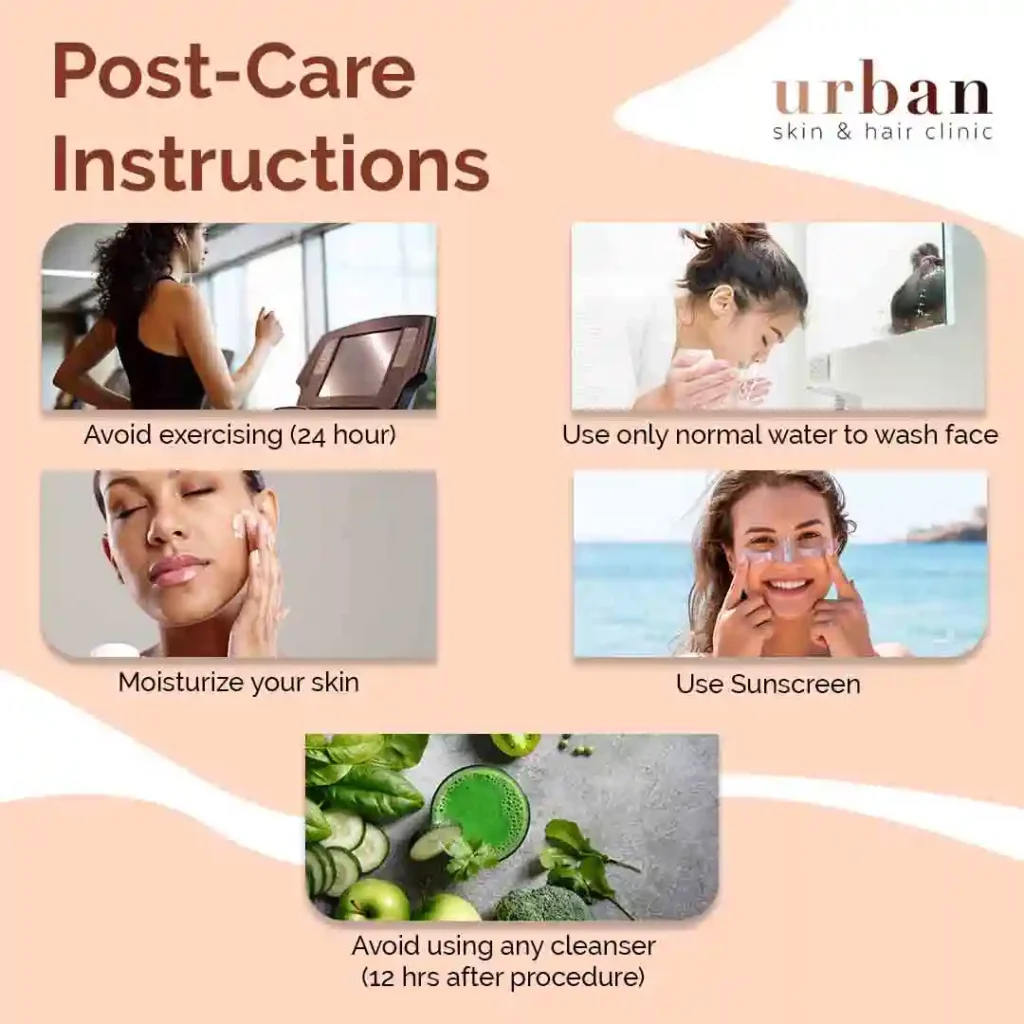
Dull Skin Treatment Cost in India
The cost of dull skin treatment in India varies depending on the type of treatment you choose. For example, the cost of a Carbon Peel session can range from Rs 4,000 to Rs 5,000, while the average cost of a chemical peel treatment for dull skin ranges from Rs 1,800 to Rs 5,500. It’s important to note that the cost may also depend on the clinic you choose, as well as the location. It’s always a good idea to do some research and compare prices before making a decision.
Consult a Specialist Today
Dr. Kiran Chotaliya, M.D., Dermatology & Hair Transplant Surgeon, is a highly experienced dermatologist with a deep understanding of skin rejuvenation techniques. Dr. Chotaliya uses advanced treatments to help patients achieve vibrant, healthy skin. Her personalized approach ensures that each patient receives the best treatment for their unique skin concerns.
Dull Skin Treatment FAQ
Most patients see noticeable improvements in skin radiance and texture after just 2-3 sessions, though results vary depending on individual skin conditions.
Our treatments are non-invasive and generally well-tolerated. You may experience mild tingling or warmth during some procedures, but it is usually comfortable.
While a good skincare routine can help, professional treatments like HydraFacial, chemical peels, and microneedling provide more immediate and lasting results.
For optimal results, we recommend a series of treatments, usually spaced 2-4 weeks apart, followed by maintenance treatments every few months.
Side effects are minimal. Some patients may experience slight redness or sensitivity post-treatment, but it typically resolves within a few hours.
Why Urban Skin and Hair Clinic

TEAM OF CERTIFIED DERMATOLOGISTS

US-FDA APPROVED EQUIPMENTS

HIGHLY STANDARDISED PROTOCOLS

